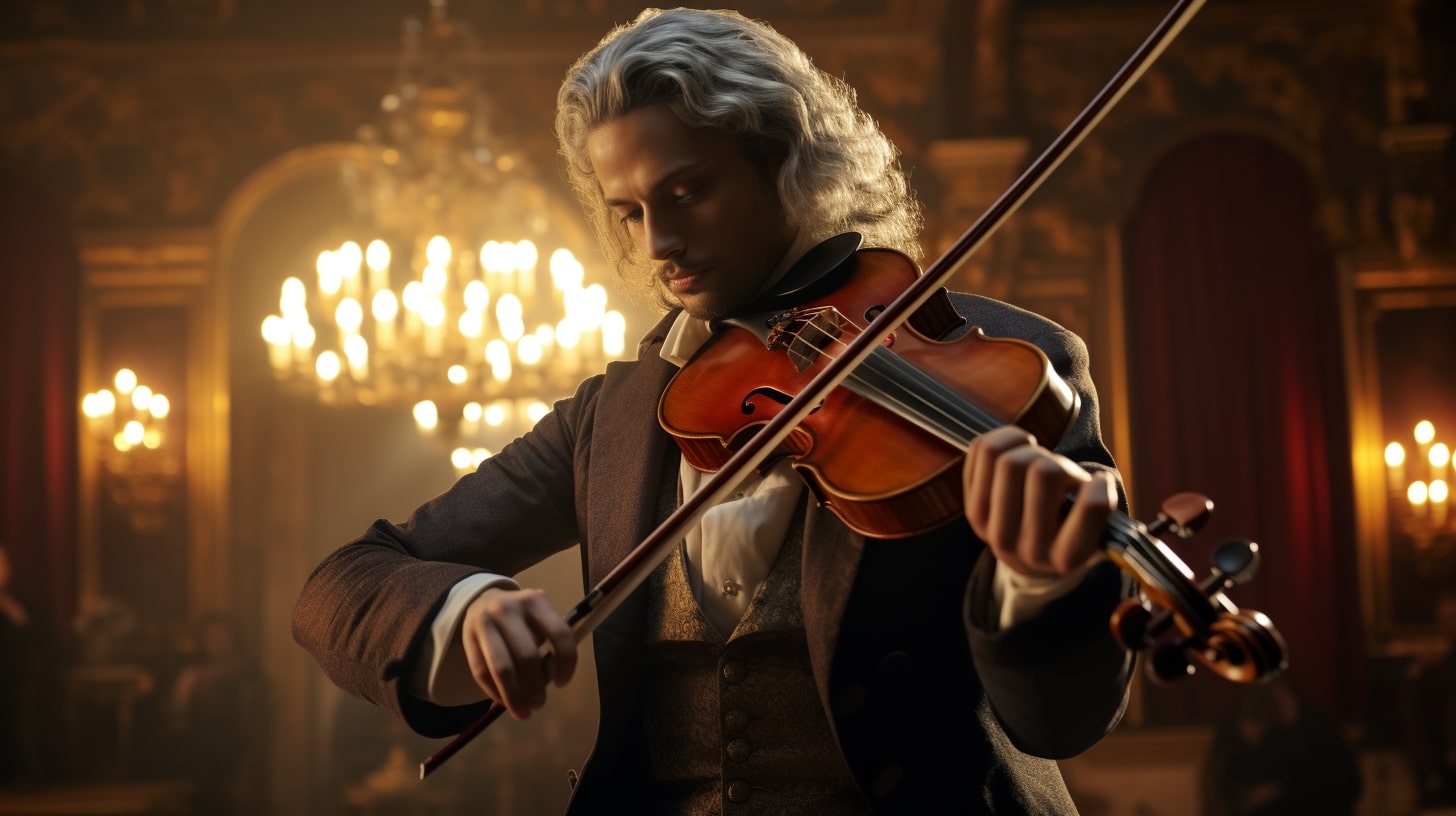Antonio Vivaldi was an influential composer and musician during the Baroque period. He left a significant mark on the form of the concerto, as well as playing a crucial role in shaping the style of Baroque instrumental music.
Antonio Vivaldi’s contribution to classical music cannot be overstated. He had a lasting impact on the musical landscape of the Baroque era and beyond.
Contents
Antonio Vivaldi’s Life
Early Life
Antonio Lucio Vivaldi was born on March 4, 1678, in Venice, Italy, to Giovanni Battista Vivaldi and his wife. His father was a professional violinist who recognized Antonio’s talent early on and taught him to play the violin. Despite being ordained as a priest later in his life, Vivaldi was often identified as the “Red Priest” due to his bright red hair.
Priesthood and Ospedale Della Pietà
In 1703, Vivaldi was ordained as a priest. However, due to his worsening health, he could not continue with his priestly duties and instead focused on his musical career. Shortly after his ordination, he began working at the Ospedale Della Pietà, a renowned music school for orphaned and disadvantaged girls.
Vivaldi composed many of his most famous works during this time, including his acclaimed violin concerto, “The Four Seasons.”
Travel and Later Years
Vivaldi’s growing success led him to travel throughout Europe, where he gained recognition and performed before esteemed audiences. His journeys took him to cities like Vienna in Austria, where he composed various operas.
Unfortunately, Vivaldi’s final years were plagued by financial hardship due to an economic crash that followed a major earthquake in his hometown of Venice.
Vivaldi moved to Vienna in 1740, likely seeking new opportunities and patronage. However, his fortunes did not improve, and he died on July 28, 1741. Vivaldi was buried in a simple grave as his once-great wealth had dwindled.
Legacy
Despite facing hardships in his later years, Antonio Vivaldi’s work continues to influence and inspire musicians to this day. His contributions to the Baroque period and the development of the violin concerto are invaluable.
With his numerous violin concertos, sacred works, and operas, Vivaldi remains a prominent figure in the world of classical music.
Vivaldi’s Music
Vivaldi’s Violin Mastery
Antonio Vivaldi left a significant mark on the form of the concerto and the style of late Baroque instrumental music. Born on March 4, 1678, in Venice, Italy, Vivaldi’s main teacher was likely his father, Giovanni Battista, a professional violinist who taught his young son to play the instrument.
This upbringing spawned a great talent, leading to Vivaldi becoming a virtuoso violinist as well as being known as the Prete Rosso, or “Red Priest,” due to his red hair.
Four Seasons
One of Vivaldi’s most famous compositions is a series of violin concertos known as the Four Seasons. These concertos are among the most popular and well-known of all Baroque music.
Each concerto represents a different season and includes three movements to depict various aspects of that season. These instrumental concertos brilliantly showcase Vivaldi’s skill in conveying vivid imagery through music, bringing the distinct atmospheres of spring, summer, autumn, and winter to life.
Concertos
Vivaldi composed almost 500 concerti throughout his career. Out of these, more than 300 are concerti for a solo instrument with string orchestra and continuo. Approximately 230 of these are written for solo violin, 40 for bassoon, 25 for cello, 15 for oboe, and 10 for flute.
This vast output of concertos serves as a testament to Vivaldi’s mastery of the form and innovation within the Baroque genre.
Operas
In addition to his instrumental works, Antonio Vivaldi composed over 50 operas throughout his career. Although many of these works have not survived or are lesser known today, they were popular in Vivaldi’s time, especially in Italian cities such as Venice and Milan.
Vivaldi’s operas display his skill in writing for the human voice and creating dramatic works for the stage.
Gloria and Other Choral Works
Vivaldi also composed sacred choral music, including the famous Gloria, which remains a popular piece within the repertoire of choirs worldwide. This work showcases Vivaldi’s ability to blend his distinctive instrumental style with choral music, creating powerful and emotive expressions of faith.
In addition to Gloria, his choral compositions include Stabat Mater and multiple settings of the Magnificat. These works further solidify Vivaldi’s place as one of the most prominent Baroque composers.
Vivaldi’s Style and Influence
Artistry
Antonio Vivaldi was a virtuoso violinist and an influential composer during the Baroque period. His violin mastery allowed him to showcase innovative techniques and ideas in his compositions.
He profoundly impacted the form of the concerto and the style of late Baroque instrumental music. Vivaldi’s extensive knowledge of keys and his preference for melodies in E major helped him craft vibrant and lively works, such as “Spring” from his renowned composition “The Four Seasons.”
Impact on Baroque Music
Vivaldi’s contributions to the Baroque era encompassed both the world of music and broader cultural trends of the time. His compositions incorporated elements from literature, science, technology, and visual arts, reflecting a deep understanding of the rich tapestry of Baroque society.
Vivaldi’s innovative approach to the concerto form influenced many composers who followed, leaving a lasting legacy on the development of Baroque music and beyond.
One notable fact about Vivaldi’s impact on music history is his powerful influence on Johann Sebastian Bach. Bach admired Vivaldi’s style and even transcribed several of Vivaldi’s concertos for keyboard instruments, contributing to the dissemination of Vivaldi’s works and further solidifying his importance in the Baroque era.
Revival in the 20th Century
Vivaldi’s music experienced a revival in the 20th century as performers and scholars began to appreciate his genius once more. This resurgence of interest in Vivaldi’s works led to a reassessment of his contribution to music history. During this time, Vivaldi’s works, like “The Four Seasons,” gained widespread popularity and recognition, securing his place as an iconic figure in classical music.
In addition, demystified videos and #wtfact videos have helped introduce Vivaldi’s extraordinary compositions to broader audiences, ensuring that his music continues to be celebrated in the present day.
In summary, Antonio Vivaldi’s artistry, impact on Baroque music, and 20th-century revival serve as testaments to his enduring influence on the world of classical music. His mastery of the violin and innovations within the concerto form continues to inspire artists and musicians across generations.


